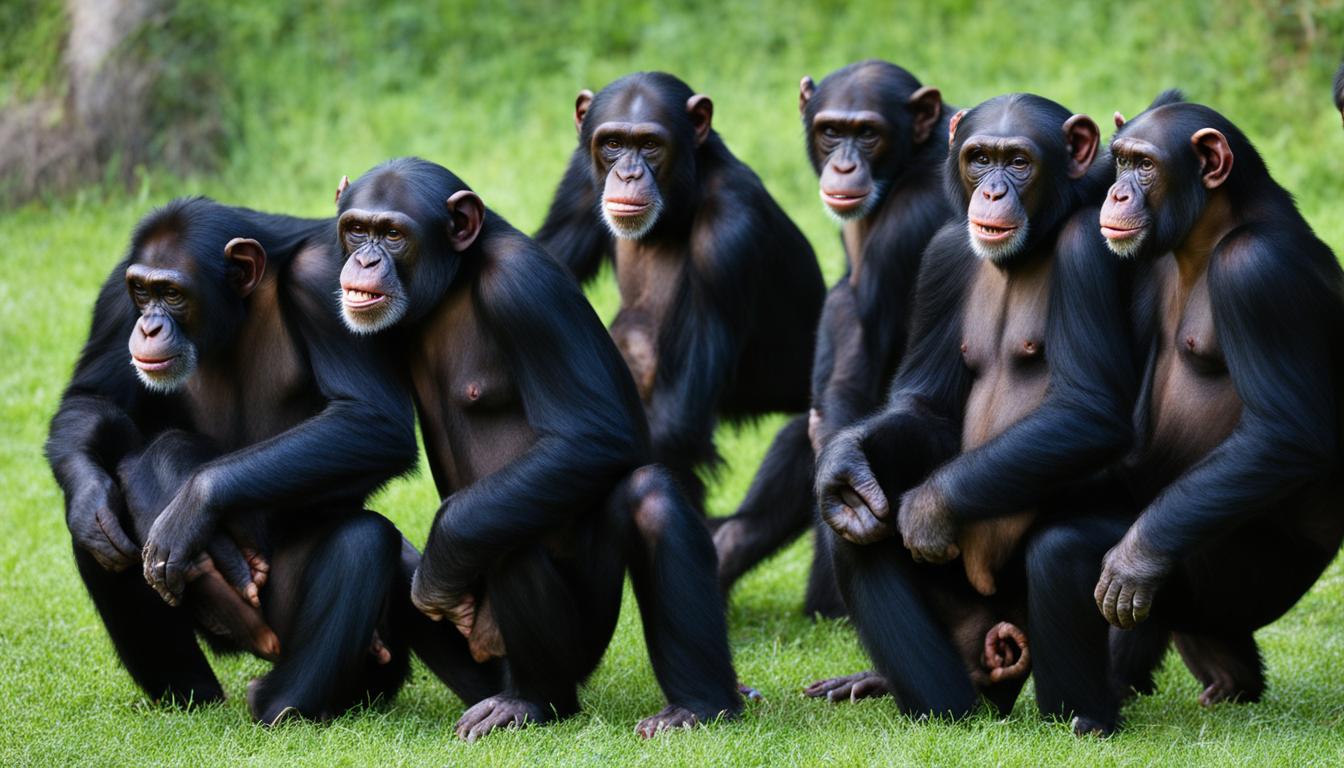Chimpanzees, also known as chimps, have a fascinating social structure that revolves around dominance hierarchies and group dynamics. Similar to humans, these intelligent primates establish a highly structured social organization within their groups. Understanding how social hierarchies are formed among chimpanzees offers valuable insights into their behavior and social relationships.
Example of Coalition Dynamics
| Chimpanzee | Coalition Members | Outcome |
|---|---|---|
| Tom | Sam, Alex | Tom successfully challenges the alpha male with the support of his coalition, leading to a shift in power. |
| Charlie | Ben, Max | The coalition fails to dethrone the alpha male, but their alliance helps Charlie secure a higher social status within the group. |
| Harry | Luke, Jake, Lucas | The coalition forms but faces internal conflicts, leading to a breakdown and no significant change in dominance. |
The example above demonstrates how coalitions can influence the power dynamics within a chimpanzee group. These alliances can have varying degrees of success, impacting the dominance hierarchy and social interactions among males.
Female Hierarchy and Reproductive Success
Within a chimpanzee group, females establish their own hierarchy, with the alpha female at the top. This social rank plays a crucial role in determining reproductive success, food access, and maternal status. Higher-ranking females tend to have greater reproductive success, as they have priority access to mating opportunities and resources. Their offspring also have better social prospects, with a higher chance of achieving a high status themselves. The alpha female, as the top-ranking female, maintains social order among females by asserting her dominance over lower-ranking individuals.
Aggression is a tool used by the alpha female to uphold her position in the hierarchy and control access to resources. By studying the female hierarchy and its impact on reproductive success, researchers gain valuable insights into the social dynamics of chimpanzee communities. It allows us to understand the intricate balance of power and social interactions among females, shedding light on the complexities of their society.
| Benefits of Higher Rank | Consequences of Lower Rank |
|---|---|
| Greater reproductive success | Reduced mating opportunities |
| Priority access to food sources | Limited food availability |
| Enhanced social prospects for offspring | Lower social status for offspring |
Conflict and Warfare in Chimpanzee Groups
Chimpanzee groups, despite their social structures, are not immune to conflict and warfare. Instances of intergroup warfare, like the Gombe Chimpanzee War, have been observed by researchers. This war lasted for four years and led to the unfortunate death of several individuals. The primary causes of warfare in chimpanzee groups are conflicts over territory and mating rights. Male aggression and competition for resources often result in violent encounters between different chimpanzee communities. By studying the factors that contribute to conflict in chimpanzee groups, researchers gain valuable insights into the evolution of social behavior and the complex dynamics of their society.
The Complexity of Chimpanzee Behavior
Chimpanzee behavior is fascinatingly complex and goes well beyond the establishment of social hierarchies. While dominance and competition play a significant role in their society, chimpanzees also exhibit various altruistic behaviors, form deep friendships, and actively engage in resource sharing.
One of the most remarkable aspects of chimpanzee behavior is their ability to demonstrate social bonding through activities such as grooming, play, and other affiliative interactions. These behaviors strengthen social relationships, forge bonds within the group, and contribute to a sense of cohesion and harmony.
Studying these complex behaviors provides researchers with a deeper understanding of the social lives of chimpanzees and sheds light on their similarities to human social systems. Their capacity for altruism, the formation of genuine friendships, and the willingness to share valuable resources highlights the depth of their social intelligence and social behavior.
As we delve deeper into the world of chimpanzees, we discover that there is always more to learn about these magnificent primates and their intricate social dynamics. By uncovering the intricacies of chimpanzee behavior, we gain insight into the evolution of social behavior and the fundamental drivers of social bonding in both our closest primate relatives and ourselves.
Do social hierarchies in chimpanzee groups play a role in their family structure in the wild?
Social hierarchies in chimpanzee groups do play a significant role in their family structures in the wild. The dominant males and females have more access to resources and mating opportunities, which ultimately affects the dynamics of chimpanzee family structures in the wild.
– How do social hierarchies within chimpanzee groups impact their overall function and dynamics?
Social hierarchies within chimpanzee groups play a crucial role in shaping chimpanzee group dynamics and function. The hierarchical structure influences crucial behaviors such as mating, foraging, and conflict resolution. Dominant individuals often have access to more resources, while lower-ranking individuals must navigate complex social relationships to survive within the group.











